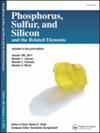通过机械密度泛函理论计算,了解烷基硼烷与Corey 's ylide多同源化的受控活性行为
IF 1.6
4区 化学
Q4 CHEMISTRY, INORGANIC & NUCLEAR
Phosphorus, Sulfur, and Silicon and the Related Elements
Pub Date : 2025-08-13
DOI:10.1080/10426507.2025.2548583
引用次数: 0
摘要
以二甲基亚砜甲基化铵(Corey 's ylide)为亚甲基源,研究了三烷基硼烷的多同源性。这种反应机制产生一种叫做聚亚甲基(PM)的线性脂肪族聚合物。我们使用密度泛函理论(DFT)进行的理论计算表明,这种聚合涉及两个反应步骤:酰基配位成三烷基硼烷(BR3)(盐配合物)和亚甲基单元插入(1,2-迁移)到B-R键,以及作为副产物的二甲亚砜(DMSO)的释放。研究了烷基链在硼烷中单臂、单臂和不对称扩散的机理,结果表明,烷基硼烷的对称多同化(单臂)途径更受青睐,从而形成具有对称烷基链的多同化硼烷。随着进一步的氧化处理,这产生了具有窄分散性的PM (ÐM),涉及活性聚合,如实验报告中所述。本文章由计算机程序翻译,如有差异,请以英文原文为准。
Understanding the controlled living behavior of the polyhomologation of alkylboranes with Corey’s ylide through mechanistic density functional theory calculations
We investigated the polyhomologation of trialkylborane using dimethyl sulfoxonium methylide (Corey’s ylide) as a methylene source. This reaction mechanism produces a linear aliphatic polymer called polymetylene (PM). Our theoretical calculations using density functional theory (DFT) suggest that this polymerization involves two reaction steps: ylide coordination into trialkylborane (BR3) (ate complex) and insertion (1,2-migration) of the methylene unit into a B-R bond, along with the liberation of dimethyl sulfoxide (DMSO) as a by-product. The mechanistic routes of the single-arm, arm-per-arm, and asymmetric propagation of the alkyl chains in the borane were explored, which revealed that the route of symmetric polyhomogation (arm-per-arm) of alkyl borane was favored over the others, leading to polyhomologated boranes with symmetric alkyl chains. With further oxidative treatment, this gave rise to PM with narrow dispersity (ÐM) involving living polymerization as in experimental reports.
求助全文
通过发布文献求助,成功后即可免费获取论文全文。
去求助
来源期刊
CiteScore
2.60
自引率
7.70%
发文量
103
审稿时长
2.1 months
期刊介绍:
Phosphorus, Sulfur, and Silicon and the Related Elements is a monthly publication intended to disseminate current trends and novel methods to those working in the broad and interdisciplinary field of heteroatom chemistry.

 求助内容:
求助内容: 应助结果提醒方式:
应助结果提醒方式:


